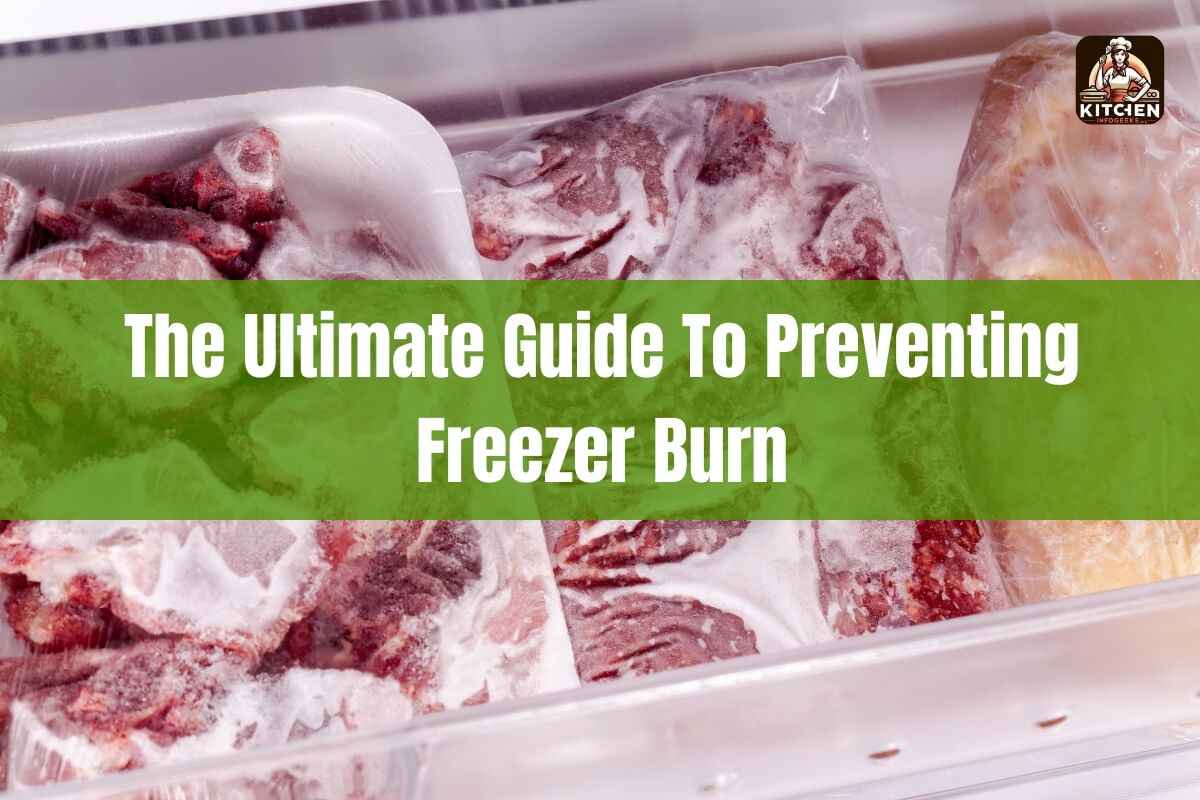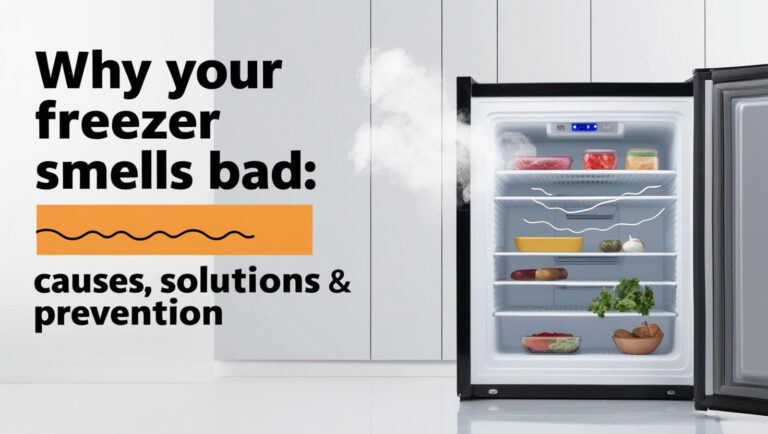
Have you ever opened your freezer to find a package of frozen meat or vegetables covered in ice crystals or discolored patches? That unappetizing sight is the dreaded freezer burn. Freezer burn happens when air reaches the frozen food, causing moisture to evaporate and leave dry, tough spots. Not only does it make your food look unappetizing, but it can also negatively impact the taste, texture, and quality.
In this comprehensive guide, we’ll explore what freezer burn is, what causes it, and most importantly, how to prevent it from ruining your frozen foods. We’ll cover tips and techniques for proper freezer maintenance, storage methods, wrapping techniques, and more. By following these preventative measures, you can keep your frozen goods fresh and flavorful for months.
What is Freezer Burn?
Before we dive into prevention, let’s understand what freezer burn actually is. Freezer burn occurs when air reaches the surface of frozen food, causing moisture to evaporate from the exposed areas. This dehydration leaves behind dry, leathery, or discolored spots on the food.
While freezer burn doesn’t make food unsafe to eat, it does significantly impact the quality. Freezer-burned foods can taste dry, tough, and bland, with an unpleasant texture. In severe cases, the affected areas may even develop an off-flavor or odor.
Top Causes of Freezer Burn
Freezer burn can strike any frozen food, but certain factors increase the risk. Understanding the root causes is key to effective prevention:
Improper Packaging/Exposure to Air: Air exposure is the primary culprit. Foods that aren’t wrapped or sealed properly allow air to circulate and steal moisture.
Temperature Fluctuations: Inconsistent freezer temperatures, whether too warm or fluctuating, can accelerate freezer burn.
Overstuffed Freezer: Cramming too much into your freezer blocks air circulation, creating temperature variations.
Lengthy Storage Time: The longer food remains frozen, the higher the risk of freezer burn, even with proper packaging.
Tips to Prevent Freezer Burn on All Your Frozen Foods
Now that we know what freezer burn is and what causes it, let’s explore practical tips to keep your frozen goods fresh and burn-free.
Maintain Proper Freezer Temperature
Maintaining the right freezer temperature is crucial for preventing freezer burn. Most freezers should be set between 0°F (-18°C) and -10°F (-23°C) for optimal frozen food storage. Regularly check your freezer’s temperature with an appliance thermometer and adjust the settings as needed.
Consistent cold temperatures help food freeze rapidly and evenly, forming smaller ice crystals that are less likely to cause dehydration and freezer burn over time.
Use Airtight Packaging
Since air exposure is enemy number one when it comes to freezer burn, using airtight packaging is a must. Invest in a vacuum sealer for the ultimate air-tight seal, or use thick, high-quality freezer bags and containers. Squeeze out any excess air before sealing.
For added protection, you can wrap items in an extra layer of plastic wrap, aluminum foil, or freezer paper before placing them in bags or containers. This helps create an additional moisture barrier.
Allow Food to Cool Completely
It’s tempting to pop hot leftovers or freshly cooked items straight into the freezer to save time. However, putting hot foods directly into the freezer increases condensation and moisture exposure, leading to freezer burn.
Always allow cooked foods to cool completely before freezing. You can speed up the cooling process by portioning foods into smaller, shallow containers and refrigerating them first.
Wrap Foods Properly
Proper wrapping is essential, even when using freezer-safe bags or containers. Tightly wrap items in plastic wrap, aluminum foil, freezer paper, or pressing the air out of bags before sealing. For oddly shaped foods like meat or fish, double-wrapping helps eliminate air pockets.
Some items, like baked goods or ice cream, benefit from additional protection. Place a layer of parchment or wax paper between slices of bread or directly on the surface of ice cream to create a barrier.
Don’t Overstuff the Freezer
While maximizing freezer space is tempting, an overstuffed freezer restricts airflow and makes it harder to maintain consistent temperatures throughout. This creates cold and warm pockets that increase the risk of freezer burn.
Leave some space between items, and avoid blocking vents or fans. Regularly reorganizing and removing foods you don’t plan to use can help free up space.
Freeze Fresh Foods Promptly
The fresher your food is when frozen, the better quality it will maintain during frozen storage. Freeze items as soon as possible after purchasing or cooking them. Letting fresh produce, meats, or leftovers linger in the refrigerator before freezing reduces their shelf life and makes them more susceptible to freezer burn.
Use Older Foods First
No matter how well you store and package frozen foods, their quality will degrade over time in the freezer. Use a first-in, first-out (FIFO) system by labeling all packages with the freezing date. Prioritize using up older items first, before newer ones, to minimize the risk of freezer burn on aging foods.
Preventing Freezer Burn on Specific Foods
While the general tips above apply to most frozen foods, some items benefit from special handling to prevent freezer burn. Here are some food-specific techniques:
Meats and Seafood
Vacuum sealing is ideal for preventing freezer burn on raw meats, fish, and seafood. The tight seal eliminates air exposure. If vacuum sealing isn’t an option, tightly wrap proteins in plastic wrap, then overrap with aluminum foil or freezer paper.
For ground meats, press into a tightly packed mass before double-wrapping to minimize air pockets. Cooked meats and seafood can be frozen in airtight containers with a bit of their cooking liquid or broth to help retain moisture.
Fruits and Vegetables
Many fruits and veggies benefit from blanching before freezing to preserve texture, flavor, and nutrients. Once blanched and cooled, pat dry thoroughly. Then package in airtight freezer bags or containers, removing as much air as possible.
Delicate items like berries fare better when frozen first on baking sheets, then transferred to airtight bags or containers. This prevents clumping and freezer burn.
Baked Goods
When freezing bread, rolls, muffins, or other baked goods, wrap tightly in plastic wrap and foil, or use an airtight bread box or freezer bag. For added protection, place a layer of parchment between slices or halves.
Wrap items like pies or cakes thoroughly in a couple of layers of wrapping before freezing. Unfrosted cakes may benefit from covering the cut sides with frosting or wax paper to seal in moisture.
Prepared Meals/Leftovers
Most cooked dishes and leftovers freeze well in airtight, freezer-safe containers or bags. Allow foods to cool completely first. Removing as much air as possible from containers helps minimize freezer burn.
Saucy items like stews, curries, or pasta dishes with sauce can be frozen with a bit of liquid to create an ice glaze on top once frozen. This seals in moisture during storage.
Signs of Freezer Burn and What to Do
Even with diligent prevention efforts, freezer burn may still occur over lengthy frozen storage times. Recognizing the signs of freezer burn can help you determine whether the food is still usable or not.
Freezer burn appears as grayish-brown leathery or dried-out spots on the surface of frozen foods. In severe cases, ice crystals may also form, and the food may develop an off-flavor or odor.
For mildly freezer-burned items, you can cut away any dried or discolored portions before cooking or serving the unaffected areas. However, foods with severe freezer burn will likely be too dried out, tough, and flavorless to salvage palatably.
Conclusion
Preventing freezer burn is the key to preserving the quality, flavor, and freshness of your frozen foods for months on end. By following the tips outlined in this guide—maintaining consistent freezer temperatures, using airtight packaging, wrapping foods properly, and rotating your freezer inventory—you can significantly reduce moisture loss and dehydration.
Not only will your frozen items look and taste better, but you’ll also minimize food waste and get more value out of the goods you freeze. So take the time to implement these freezer burn prevention techniques, and enjoy fresh-tasting, high-quality frozen meals, ingredients, and snacks.






